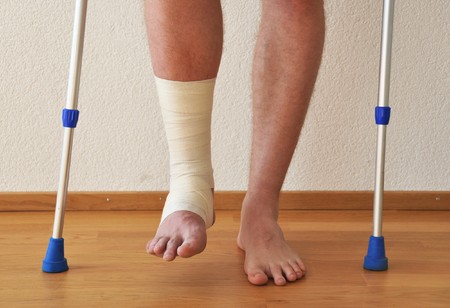WHAT IS A BROKEN FOOT?
A broken foot is also known as a foot fracture is an injury to the bone. You might experience a broken foot during a car crash or from a simple misstep or fall.
The severity of a broken foot varies. Fractures could range from small cracks in your bones to breaks that pierce your skin.
Treatment for a broken foot depends on the exact area and seriousness of the fracture. A severely broken foot might need surgery to implant plates, rods or screws into the broken bone to maintain proper position during recovery.
BROKEN FOOT SYMPTOMS
If you have a broken foot, you might experience some of the following signs and symptoms:
- Immediate, throbbing pain
- Pain that increases with activity and decreases with rest
- Swelling
- Bruising
- Tenderness
- Deformity
- Trouble in walking or bearing weight

WHEN SHOULD YOU SEE A DOCTOR?
See a doctor or primary care physician if there is an obvious deformity, if the pain and inflammation do not get better with self-care, or if the pain and inflammation get worse over time. Also, see a doctor or primary care physician if the injury interferes with walking.
BROKEN FOOT CAUSES
The most frequent causes of a broken foot include:
Car accidents – The crushing injuries common in car accidents might cause breaks that need surgical repair.
Falls – Tripping, and falling could break bones in your feet, as could landing on your feet after jumping down from just a slight height.
The impact from a heavyweight – Dropping something heavy on your foot is a frequent cause of fractures.
Missteps – Sometimes just putting your foot down wrong could result in a broken bone. A toe could get broken from stubbing your toes on furniture.
Overuse – Stress fractures are frequent in the weight-bearing bones of your feet. These small cracks are generally caused over time by repetitive force or overuse, like running long distances. But they could also happen with the normal use of a bone that is been weakened by a condition like osteoporosis.
BROKEN FOOT RISK FACTORS :-
You might be at higher risk of a broken foot or ankle if you:
Participate in high-impact sports – The stresses, direct blows, and twisting injuries that happen in sports like basketball, football, gymnastics, tennis, and soccer could cause foot fractures.
Use improper technique or sports equipment – Faulty equipment, like shoes that are too worn or not properly fitted, could contribute to stress fractures and falls. Improper training techniques, like not warming up and stretching, also could cause foot injuries.
Unexpectedly increase your activity level – Whether you are a trained athlete or someone who’s just started exercising, unexpectedly boosting the frequency or duration of your exercise sessions could increase your risk of a stress fracture.
Work in specific occupations – Specific work environments, like a construction site, put you at risk of falling from a height or dropping something heavy on your foot.
Keep your home cluttered or poorly lit – Walking around in a house with too much clutter or too little light might lead to falls and foot injuries.
Have specific conditions – Having decreased bone density (osteoporosis) could put you at risk of injuries to your foot bones.
BROKEN FOOT COMPLICATIONS
Complications of a broken foot are uncommon but might include:
Arthritis – Fractures that extend into a joint could cause arthritis years later. If your foot begins to hurt long after a break, see your doctor or primary care physician for an evaluation.
Bone infection (osteomyelitis) – If you have an open fracture, meaning one end of the bone protrudes through the skin, your bone might be exposed to bacteria that cause infection.
Nerve or blood vessel damage – Trauma to the foot could injure adjacent nerves and blood vessels, sometimes actually tearing them. Look for immediate attention if you notice any numbness or circulation problems. Lack of blood flow could cause a bone to die and collapse.
BROKEN FOOT PREVENTION :-
These basic sports and safety tips might help prevent a broken foot:
Wear proper shoes – Use hiking shoes on rough land. Wear steel-toed boots in your work environment if required. Choose proper athletic shoes for your sport.
Replace athletic shoes regularly – Throw away sneakers as soon as the tread or heel wears out or if the shoes are wearing unevenly. If you are a runner, replace your sneakers every 300 to 400 miles.
Start gradually – That applies to a new fitness program and every single workout.
Cross-train – Alternating activities could prevent stress fractures. Rotate running with swimming or biking.
Build bone strength – Calcium-rich foods, like milk, yogurt, and cheese, really could do your body good. Taking vitamin D supplements also could help.
Use night lights – Many broken toes are the consequence of walking in the dark.
Declutter your house – Keeping clutter off the floor could help you to avoid trips and falls.
BROKEN FOOT DIAGNOSIS
During the physical examination, your doctor or primary care physician will check for points of tenderness in your foot. The exact location of your pain could help determine its cause.
They might move your foot into different positions, to check your range of motion. You might be asked to walk for a short distance so that your doctor or primary care physician could examine your gait.
Imaging tests
If your signs and symptoms suggest a break or fracture, your doctor or primary care physician might recommend one or more of the following imaging tests.
X-rays – Most foot fractures could be visualized on X-rays. The technician might require to take X-rays from various different angles so that the bone pictures would not overlap too much. Stress fractures usually do not show up on X-rays until the break actually begins recovering.
Bone scan – For a bone scan, a technician will administer a small amount of radioactive material into a vein. The radioactive material is attracted to your bones, particularly the parts of your bones that have been damaged. Damaged regions, including stress fractures, show up as bright spots on the resulting image.
Computerized tomography (CT) – CT scans take X-rays from many different angles and combine them to make cross-sectional pictures of internal structures of your body. CT scans could reveal more detail about the bone and the soft tissues that surround it, which might help your doctor or primary care physician determine the best treatment.
Magnetic resonance imaging (MRI) – MRI uses radio waves and a strong magnetic field to create very detailed pictures of the ligaments that help hold your foot and ankle together. This imaging helps to show ligaments and bones and could identify fractures not seen on X-rays.

BROKEN FOOT TREATMENT
Treatments for a broken foot will vary, depending on which bone has been broken and the seriousness of the injury.
Medications
Your doctor or primary care physician might suggest an over-the-counter pain reliever, like acetaminophen (Tylenol, others).
Therapy
After your bone has healed, you will probably require to loosen up stiff muscles and ligaments in your feet. A physical therapist could teach you exercises to improve your flexibility and strength.
Surgical and other procedures
Reduction – If you have a displaced fracture, meaning the two ends of the fracture are not aligned, your doctor or primary care physician might require to manipulate the pieces back into their proper positions a process known as reduction. Depending on the amount of pain and inflammation you have, you might require a muscle relaxant, a sedative, or even a general anesthetic before this procedure.
Immobilization – To heal, a broken bone should be immobilized so that its ends could knit back together. In most cases, this needs a cast.
Minor foot fractures might only require a removable brace, boot, or shoe with a stiff sole. A fractured toe is generally taped to a neighboring toe, with a piece of gauze between them.
Surgery – In some cases, an orthopedic surgeon might require to use pins, plates, or screws to maintain the proper position of your bones during healing. These materials might be removed after the fracture has healed if they are prominent or painful.
If you or anyone you know is suffering from a broken foot, our expert providers at Specialty Care Clinics will take care of your health and help you recover.
Call 469-545-9983 to book a telehealth appointment for an at-home check-up.
